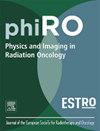健康志愿者在动态轨迹放疗中对工作台旋转耐受的随机安全性研究
IF 3.3
Q2 ONCOLOGY
引用次数: 0
摘要
本研究旨在表明动态轨迹放疗(DTRT)的桌面移动并不比标准护理的非共面体积调制电弧治疗(ncVMAT)引起更多的晕动病。41名健康志愿者在四个不同的随机分配序列中进行了DTRT和ncVMAT的干跑。主要结果是运动病评估问卷(MSAQ)的总得分。DTRT和ncVMAT试验前后MSAQ综合评分的平均变化分别为1.88和1.62。两种方法的差异为0.26 [95% CI: - 0.24至0.75];在健康志愿者中,CI显示DTRT对ncVMAT治疗晕动病的非劣效性。本文章由计算机程序翻译,如有差异,请以英文原文为准。
A randomized safety study of tolerance to table rotation in dynamic trajectory radiotherapy in healthy volunteers
This study aimed to show that table movement of dynamic trajectory radiotherapy (DTRT) does not induce more motion sickness than standard-of-care non-coplanar volumetric modulated arc therapy (ncVMAT). Forty-one healthy volunteers underwent dry-runs of DTRT and ncVMAT in four different, randomly allocated sequences. The primary outcome was the Motion Sickness Assessment Questionnaire (MSAQ) summary score. The average change in MSAQ summary score before to after dry-runs was 1.88 for DTRT and 1.62 for ncVMAT. The difference between both techniques was 0.26 [95% CI: −0.24 to 0.75]; the CI demonstrated non-inferiority of DTRT to ncVMAT for motion sickness in healthy volunteers.
求助全文
通过发布文献求助,成功后即可免费获取论文全文。
去求助
来源期刊

Physics and Imaging in Radiation Oncology
Physics and Astronomy-Radiation
CiteScore
5.30
自引率
18.90%
发文量
93
审稿时长
6 weeks
 求助内容:
求助内容: 应助结果提醒方式:
应助结果提醒方式:


